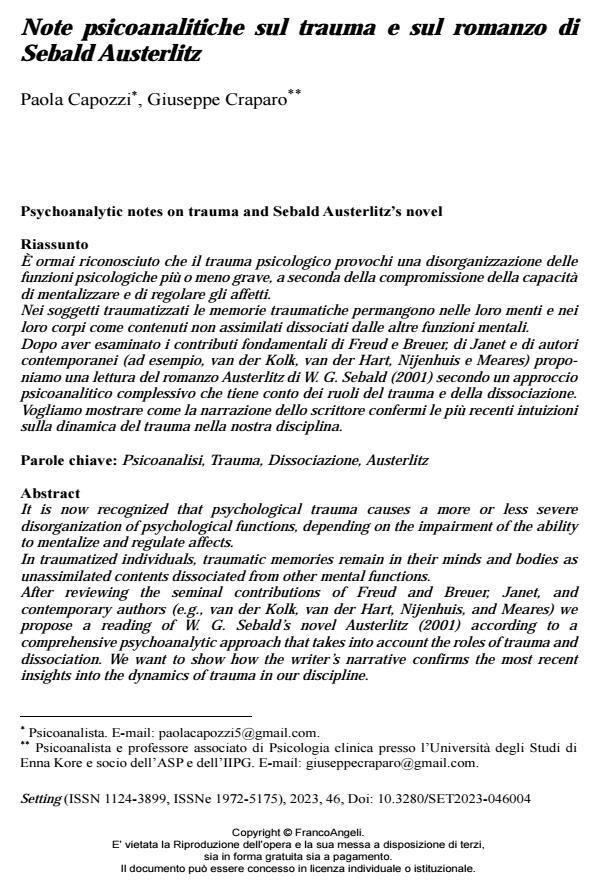Psychoanalytic notes on trauma and Sebald Austerlitz’s novel
Journal title SETTING
Author/s Paola Capozzi, Giuseppe Craparo
Publishing Year 2024 Issue 2023/46 Language Italian
Pages 18 P. 73-90 File size 314 KB
DOI 10.3280/SET2023-046004
DOI is like a bar code for intellectual property: to have more infomation
click here
Below, you can see the article first page
If you want to buy this article in PDF format, you can do it, following the instructions to buy download credits

FrancoAngeli is member of Publishers International Linking Association, Inc (PILA), a not-for-profit association which run the CrossRef service enabling links to and from online scholarly content.
It is now recognized that psychological trauma causes a more or less severe disorganization of psychological functions, depending on the impairment of the ability to mentalize and regulate affects. In traumatized individuals, traumatic memories remain in their minds and bodies as unassimilated contents dissociated from other mental functions. After reviewing the seminal contributions of Freud and Breuer, Janet, and contemporary authors (e.g., van der Kolk, van der Hart, Nijenhuis, and Meares) we propose a reading of W. G. Sebald’s novel Austerlitz (2001) according to a comprehensive psychoanalytic approach that takes into account the roles of trauma and dissociation. We want to show how the writer’s narrative confirms the most recent insights into the dynamics of trauma in our discipline.
Keywords: Psychoanalysis, Trauma, Dissociation, Austerlitz
- Agazzi E. (2012). W. G. Sebald: in difesa dell’uomo. Firenze, Le Lettere.
- Barthes R. (1980). La chambre claire. Note sur la photographie. Cahiers du Cinéma, Seuil, Gallimard.
- Breuer J., Freud S. (1892-1895). Studi sull’isteria. O.S.F., 3.
- Bromberg P. (1998). Clinica del trauma e della dissociazione. Standing in the spaces. Milano, Cortina, 2007.
- Calzoni R. (2005). Walter Kempowski, W.G. Sebald e i tabù della memoria collettiva tedesca. Passian di Prato, Campanotto.
- Chefetz R, A. (2015). Psicoterapia intensiva per processi dissociativi persistenti. Roma, Fioriti, 2018.
- Craparo G., Ortu F., van der Hart O. (2019). Rediscovering Pierre Janet: Trauma, Dissociation, and a New Context for Psychoanalysis. London, Routledge.
- Duttinger C. (2004). Traumatic Photographs: Resemblance and the Technical Media in W.G. Sebald’s Austerlitz. In W. G. Sebald. A Critical Companion. Seattle, University of Washington Press.
- Freud S. (1906). Il delirio e i sogni nella “Gradiva” di Wilhelm Jensen. O.S.F., 5.
- Freud S. (1919). Il perturbante. O.S.F., 9.
- Freud S (1920). Al di là del principio di piacere. O.S.F., 9.
- Freud S. (1925). Inibizione, sintomo e angoscia. O.S.F., 10.
- Freud S. (1927). Il feticismo.
- Freud S. (1938). La scissione dell’Io nel processo di difesa. O.S.F., 11.
- Janet P. (1889). L’automatismo psicologico. Saggio di psicologia sperimentale sulle forme inferiori dell’attività umana. Milano, Cortina, 2013.
- Janet P. (1909). Les Névroses. Paris, Flammarion.
- Janet P. (2016). Trauma, coscienza, personalità. Milano, Cortina.
- Klein M (1946). Note su alcuni meccanismi schizoidi. In Scritti. Torino, Boringhieri.
- Kluge A. (2008). L’incursione aerea su Halberstadt dell’8 aprile 1945. Milano, Meltemi, 2019.
- Liotti G., Farina B. (2011). Sviluppi traumatici. Milano, Cortina.
- Meares R. (2012). Un modello dissociativo del disturbo borderline di personalità. Milano, Cortina, 2014.
- Mittner L. (1978). Storia della letteratura tedesca, III [Dal fine secolo alla sperimentazione (1890-1970)]. Torino, Einaudi.
- Nijenhuis E.R.S. (2009). Somatoform dissociation and somatoform dissociative disorders. In P.F. Dell, & J. O’Neil (Eds.). Dissociation and dissociative disorders: DSM-IV and beyond (pp. 259-277). New York, Routledge.
- Rosenfeld H. (1946). Stati psicotici. Roma, Armando, 1951.
- Sebald W.G. (2001). Austerlitz. Milano, Adelphi, 2002.
- Sebald W. G. (2001). Storia naturale della distruzione. Milano, Adelphi, 2004.
- van der Hart O., Nijenhuis E.R.S., Steele K. (2006). The Haunted Self: Structural Dissociation and the Treatment of Chronic traumatization. New York, W.W. Norton.
- van der Kolk B. (2014). Il corpo accusa il colpo. Milano, Cortina, 2015.
Paola Capozzi, Giuseppe Craparo, Note psicoanalitiche sul trauma e sul romanzo di Sebald Austerlitz in "SETTING" 46/2023, pp 73-90, DOI: 10.3280/SET2023-046004